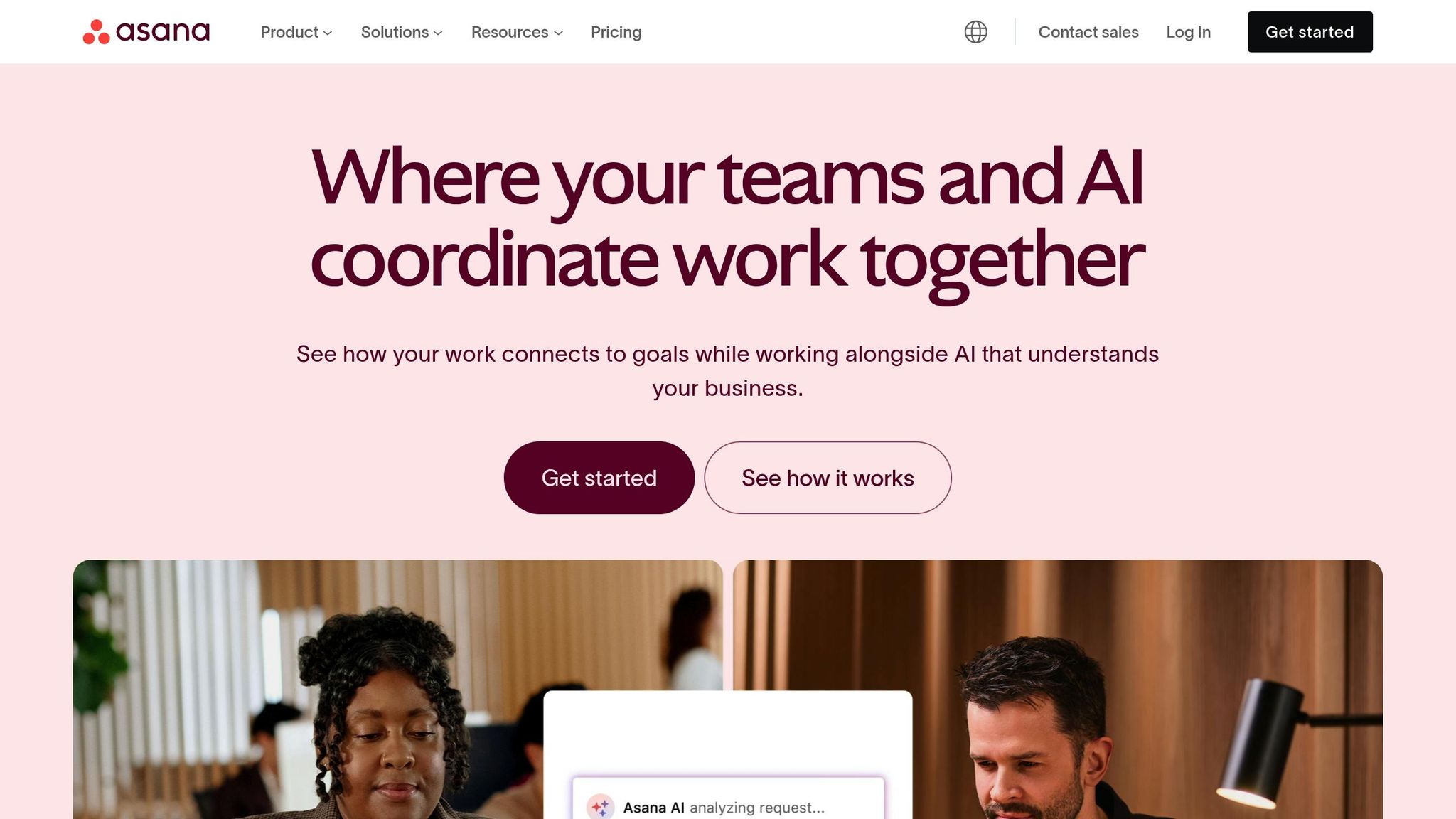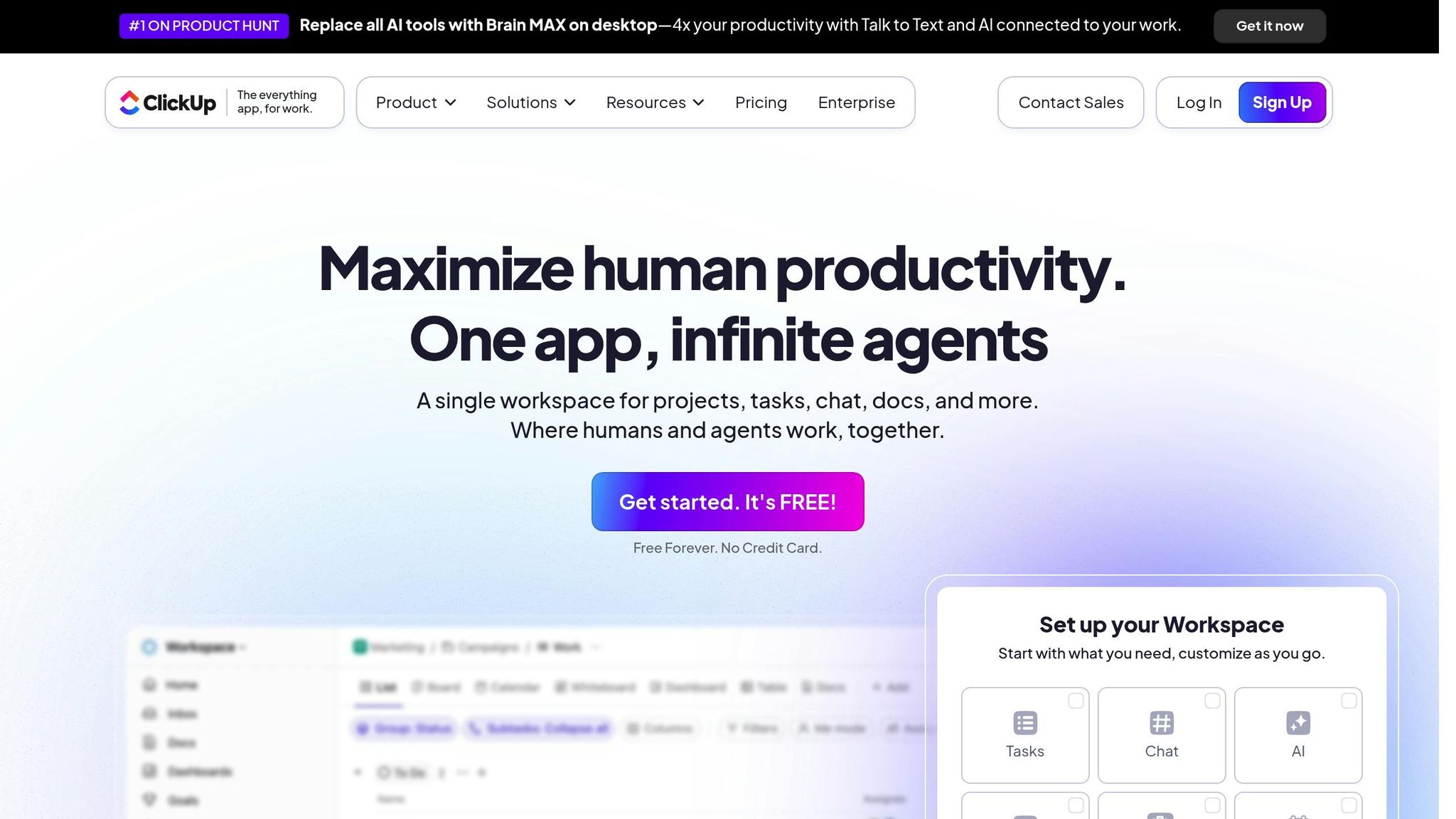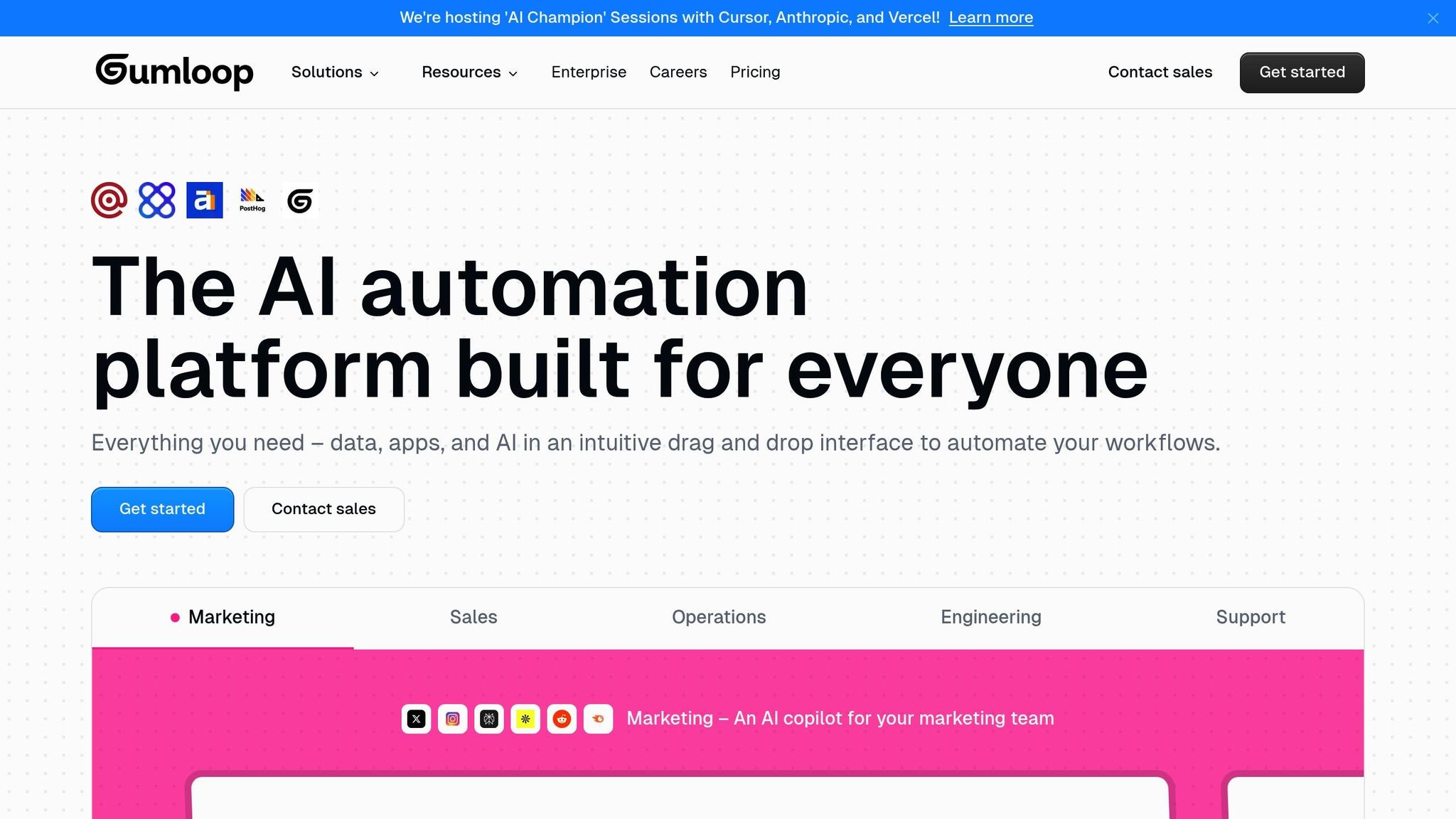Looking for free AI tools to improve your workflow? Here’s a quick guide to three top options: Asana, ClickUp, and Gumloop. These tools help organize tasks, automate repetitive processes, and streamline team collaboration - all without a price tag.
Key Takeaways:
- Asana: Ideal for smaller teams. Offers task management, project insights, and basic automation for up to 10 users.
- ClickUp: Perfect for larger teams. Unlimited users, multiple project views, and collaborative features.
- Gumloop: Best for visual thinkers. Uses a canvas-based interface and natural language AI for workflow automation.
Quick Comparison:
| Feature | Asana | ClickUp | Gumloop |
|---|---|---|---|
| Team Size | Up to 10 users | Unlimited | Best for individuals |
| AI Features | Workflow insights | Task management AI | Natural language-based |
| Views | List, Board, Calendar | Multiple (incl. Time) | Visual canvas |
| Automation | Basic (advanced paid) | Limited free automation | Credits-based system |
| Integrations | Wide compatibility | Standard integrations | Essential integrations |
Each has its strengths, so choose based on your team size, automation needs, and collaboration style. Pilot one to see how it fits your workflow.
11 Best AI Workflow Automation Tools to 10X Your Productivity in 2025
Best Free AI Tools for Workflow Management
When it comes to managing workflows, a few free tools stand out for their user-friendly design, collaborative features, and AI-powered automation. Below are three excellent options that combine AI capabilities with practical task management. While their free plans are robust, some advanced features are reserved for paid upgrades.
Asana

Asana's free Personal plan is a solid choice for individuals and smaller teams. It allows unlimited tasks and projects, offering multiple views like List, Board, and Calendar. Users can also access a mobile app and collaboration tools. The free version includes Asana AI, which provides features like smart chat, editor assistance, intelligent field suggestions, project insights, rule creation, and automated summaries. However, it’s worth noting that the free plan supports up to 10 users and doesn’t include custom fields, advanced permissions, or views like Timeline and Gantt charts. Advanced automation is also limited to paid plans.
ClickUp

ClickUp shines for its unlimited user allowance, making it ideal for teams that are scaling up. The platform includes project views, collaborative documents, time tracking, and integrations with popular business tools. It also offers project templates to help teams hit the ground running. However, the free plan has its limitations, such as restricted custom fields, no advanced roles, limited reporting, and fewer automation options. Premium integrations are also not included.
Gumloop

Gumloop takes a visual approach to workflow automation with its canvas-based interface. It features an AI assistant that simplifies workflow creation by interpreting natural language descriptions. New users are given 2,000 credits upon signup to test automation scenarios. The platform includes a drag-and-drop builder, AI-assisted workflow creation, and basic integrations. However, the free plan is less suited for more complex or heavy automation needs.
Free AI Workflow Tools Comparison
Here's a breakdown of how three popular platforms - Asana, ClickUp, and Gumloop - stack up against each other in terms of features and limitations:
| Feature | Asana | ClickUp | Gumloop |
|---|---|---|---|
| Team Size | Best for smaller teams | Designed to accommodate larger teams | Perfect for individuals |
| AI Capabilities | Uses AI for workflow insights and basic automation | Offers entry-level AI for task management | Includes an AI assistant for workflow automation using natural language commands |
| Project Views | Provides list, board, and calendar views | Features multiple views, including time tracking, alongside list, board, and calendar views | Focuses on a visual, canvas-based interface for workflow design |
| Collaboration | Includes built-in communication tools and mobile support | Allows collaborative document editing and team scaling | Covers basic sharing features |
| Automation | Offers basic automation, with advanced options in paid plans | Includes some automation features on the free plan | Relies on a credits system, which can limit heavy automation |
| Integrations | Compatible with a wide range of business tools | Provides standard integrations, with some premium-only options | Supports essential integrations |
| Templates | Comes with a limited selection of templates | Includes a variety of project templates | Features pre-built workflow templates |
| Customization | Offers basic customization; advanced options require an upgrade | Allows limited customization, such as custom fields, on the free plan | Provides essential customization tools |
Each tool has its strengths, so selecting the right one depends on your team's requirements:
- Asana is great for smaller teams looking for streamlined communication and basic automation.
- ClickUp is ideal for larger teams needing scalable solutions and multiple project views.
- Gumloop stands out for its visual, canvas-based approach to automation and workflow design.
Consider factors like team size, the level of AI integration you need, and whether you prioritize detailed reporting or a more visual interface when making your decision.
sbb-itb-212c9ea
How to Choose the Right Free AI Workflow Tool
Picking the right free AI workflow tool starts with understanding your business needs and how the tool will fit into your operations. Making the right choice becomes easier when you evaluate a few key factors systematically.
One of the first things to consider is team size. For smaller teams, tools with simple interfaces and basic collaboration features are often the best fit. For example, Asana offers an intuitive design and mobile support, making it ideal for smaller groups. Larger teams, however, need tools that can grow with them. ClickUp stands out here, with features like collaborative document editing and multiple project views that help prevent bottlenecks as teams expand.
Next, think about integration requirements. Many businesses in the U.S. already rely on established software ecosystems, so it’s essential to choose a tool that works well with your existing software stack. Asana is a strong contender here, offering compatibility with a wide range of business tools. Keep in mind, though, that some integrations may require paid upgrades, which could affect your long-term budget.
The complexity of automation your workflows require is another critical factor. For simple tasks like assigning responsibilities or setting deadline reminders, basic automation features are sufficient. But if your workflows involve multiple steps and intricate processes, you’ll need more advanced capabilities. Gumloop, for instance, excels in handling complex automation needs, though its credit system might limit heavy usage.
Visualization preferences also play a big role in user adoption. Some teams prefer traditional list views for a linear approach, while others benefit from visual layouts that show project relationships. ClickUp offers multiple views, including time tracking, to accommodate different work styles. On the other hand, Gumloop’s canvas-based interface is a great option for teams that prefer designing workflows visually.
When evaluating tools, don’t overlook budget constraints. While many tools offer free tiers, it’s important to consider the total cost of ownership. Upgrades for additional users, storage, or advanced features can quickly add up. Many businesses find themselves upgrading within 6 to 12 months as their needs grow.
For some industries, specific requirements like compliance features, security protocols, or specialized integrations may be non-negotiable. These considerations should align with your sector’s unique demands.
The learning curve of a tool can also affect its adoption and overall success. Tools like ClickUp, which offer extensive customization, often require more training and can temporarily reduce productivity during the onboarding phase. In contrast, simpler tools like Asana allow teams to get up and running quickly, though they may require workarounds for more complex workflows.
Another essential factor is data export capabilities. As your business evolves, you may need to switch platforms or migrate data. Choosing a tool that makes this process straightforward ensures long-term flexibility.
Before committing to a tool, it’s wise to pilot it with a small team or department. Testing critical workflows on a smaller scale can help you identify potential issues without disrupting your entire operation. Expanding gradually based on proven results often leads to smoother implementation.
Conclusion
AI-powered workflow tools are changing the way teams tackle bottlenecks and improve productivity. These free tools excel at automating repetitive tasks, managing projects more efficiently, and simplifying team communication.
In this roundup, we’ve highlighted tools like Activepieces, Asana, ClickUp, Lindy, and Gumloop - all offering robust workflow management without the hefty price tag. However, each free tier comes with its own set of restrictions. For instance, Gumloop operates on a credit system, ClickUp may take time to master, and Asana limits access to advanced features. That’s why it’s crucial to evaluate these tools carefully to ensure they align with your team’s specific needs.
A smart way to start is by running a pilot project. Testing these tools in a real-world scenario helps you understand how well they integrate into your workflow, how your team adapts to their interfaces, and whether their automation features suit your processes.
As your business expands, these free tools can serve as a stepping stone to more advanced solutions. The experience you gain now will be invaluable when making future decisions about workflow management.
For even more options, check out AI Apps, a platform offering over 1,000 AI tools across various categories. Its advanced filters make it easy to find the perfect workflow management tool tailored to your needs.
FAQs
What’s the best way to choose a free AI workflow management tool for my team?
To choose the best free AI workflow management tool for your team, start by evaluating the size of your team and how they collaborate. If you’re working with a smaller group, tools like Notion AI or Trello AI are great for organizing tasks and keeping communication clear. For larger teams or enterprises, Microsoft 365 Copilot offers a more advanced solution, capable of managing complex workflows and integrating with various platforms.
Make sure to check if the tool works seamlessly with your current software, supports remote or hybrid work setups, and has the flexibility to grow alongside your team. It’s also a good idea to look at user reviews and the tool’s overall reputation to ensure it meets your specific requirements. Prioritize features that boost productivity while keeping your workflow simple and efficient.
What are the downsides of free plans for AI workflow tools, and when should I consider upgrading to a paid plan?
Free plans for AI-driven workflow tools like Asana, ClickUp, and Gumloop often come with strings attached. These could be things like capped storage, fewer AI-powered features, or limited automation capabilities. For instance, free versions might exclude advanced AI tools or integrations that growing teams rely on.
If your team needs more storage, access to advanced AI features, or smoother integration with other platforms, upgrading to a paid plan might be the way to go. Paid options are particularly useful when you're looking to scale operations or streamline productivity with more sophisticated workflows and automation.
Can these AI tools work with the software my business already uses, and what should I keep in mind about integrations?
When exploring AI tools, it's essential to choose options that can easily connect with your existing software. Many tools achieve this through APIs, plugins, or third-party connectors, ensuring they work well with your current systems and support standard data formats for smooth interactions.
You’ll also want to evaluate factors like scalability, security features, and whether the tool allows modular integration. This way, you can enhance your workflows without causing interruptions. Opt for tools that are straightforward to implement and provide strong integration support to keep your operations running efficiently.



